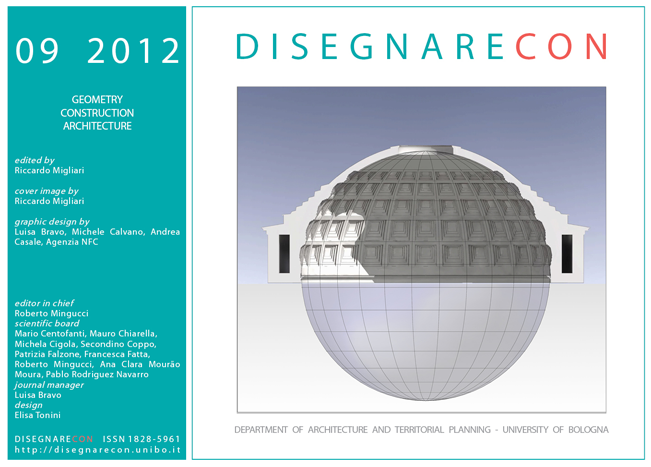Centrical plan spaces of Villa Adriana: anticipation of new aesthetics
DOI:
https://doi.org/10.6092/issn.1828-5961/3159Keywords:
Villa Adriana, 3D laser scanner, classical archaeology, 3D modeling, texturing, geometry, architectural decoration, domes, vaultsAbstract
Villa Adriana was created as a place aimed at architectural design experimentation, where the foundations for much subsequent architecture were laid: from Late Antiquity to the Baroque. In particular Hadrian wanted to exhibit in his grand palace a series of pavilions, characterized by new shapes and constructive techniques that can be considered real prototypes. Through the laser scanner survey technologies, some of these famous buildings have been analyzed and studied by means of innovative methods for representation, complemented also with an interdisciplinary collaboration with archaeologists, experts in conservation and museum curators. Some of the most significant results of this new cycle of studies, midway between new technologies and traditional research, here are exposed to ten years since their beginning.
References
ADEMBRI, Benedetta, DI TONDO, Sergio, FANTINI. Filippo (2010), Architecture with concave and convex rhythms and its decoration in Hadrian age: the south pavilion of Piazza d’Oro in Hadrian’s Villa. In proceedings of the 15th Congress on Cultural heritage and new tecnologies. Phoibos Verlag, Vienna.
AURIGEMMA, Salvatore (1996). Villa Adriana. Roma: Istituto poligrafico della Zecca dello Stato.
BETTINI, Sergio, (1992). Lo spazio architettonico da Roma a Bisanzio, Dedalo, Bari
BLOCH, Herbert (1937), I Bolli laterizi e la storia edilizia romana; la villa di Adriano a Tivoli in Bollettino Commissione Archeologica comunale di Roma 65, Roma
(1954). Bollettino d’arte n° 39 Ottobre. Roma: Ministero per i Beni e le Attività Culturali.
BOZZONI, FRANCHETTI PARDO, ORTOLANI, VISCOLIOSI (2006). L’architettura del mondo antico. (Grandi Opere, GLF editori) Roma: Laterza.
CIMA, Maddalena, LA ROCCA, Eugenio, (1995), Horti romani. Ideologia e auto rappresentazione. Atti del convegno internazionale (Roma, 4-6 Maggio), L’erma di Bretschneider, Roma.
CINQUE, Giuseppina Enrica, Adembri Benedetta (2006), Villa Adriana, la pianta del centenario, Centro Di, Firenze.
CRESCENZI Carmela, (1991), Superfici a semplice e doppia curvatura. Le ragioni geometriche delle coperture voltate in architettura, Tesi di Dottorato in Rilievo e Rappresentazione del Costruito, Palermo
CRESCENZI Carmela, (2008), Genesi dell’Architettura. Strumenti per il progetto, Tipografia il David, Firenze
DI TONDO, Sergio (2007), La forma di Villa Adriana nel territorio tiburtino. Tesi di dottorato in rilievo e rappresentazione dell’architettura e dell’ambiente, Università degli studi di Firenze
DI TONDO Sergio, NICOLI Silvia (2008). Digital survey and investigations on the shape of the ribbed vault of Villa Adriana’s Serapeo, in CAA 2008 Computer Applications and quantitative Methods in Archaeology “On the road to reconstructing the past conference
proceedings
GIUFFRIDA Alessia, LIUZZO Mariangela, SANTAGATI Cettina, (2007), Il laser scanner per il rilevamento delle opere archeologiche. Le terme dell’Indirizzo a Catania, in L. Andreozzi (a cura di), Il Rilievo dei Beni Architettonici ed Archeologici. Giornate di studio su Le nuove
frontiere del rilevamento digitale Esperienze del passato e prospettive. Atti Convegno 2005, Aracne, Roma
GROS, Pierre; TORELLI, Mario, (2007), Storia dell’Urbanistica: il mondo romano nuova ed. riv. e aggiornata, Grandi Opere, GLF 2007, editori Laterza, Roma
REGGIANI, Anna Maria (a cura di), (2000), Villa Adriana: Paesaggio antico e ambiente moderno, elementi di novità e ricerche in corso. Atti del convegno tenuto a Roma, Palazzo Massimo alle Terme il 23-24 giugno 2000 in testa al frontespizio: Ministero per i beni e le attività
culturali, Soprintendenza archeologica del Lazio, Electa, Milano
SALZA PRINA RICOTTI, Eugenia, (2001), Villa Adriana: il sogno di un imperatore. «L’Erma» di Bretschneider, Roma.
SAPELLI RAGNI, Marina (2010), Villa Adriana. Una storia Mai finita, Electa, Milano
THORSTEN, Opper (2008), Hadrian Empire and conflict, The British Museum Press, London.
VERDIANI, Giorgio, (a cura di) (2011) Il ritorno all’immagine. Nuove procedure image based per il Cultural Heritage, Lulu edizioni.
Downloads
Published
How to Cite
Issue
Section
License
Copyright (c) 2012 Sergio Di Tondo, Filippo Fantini





